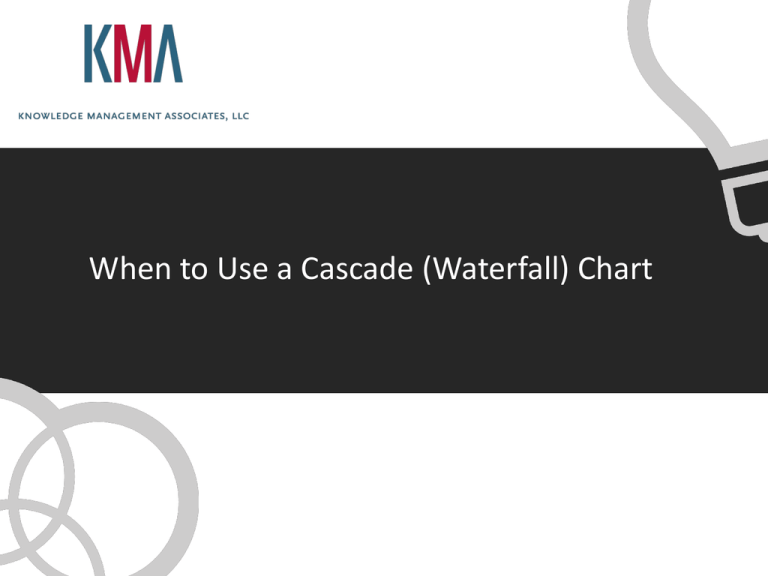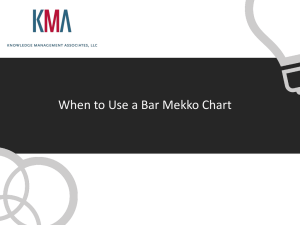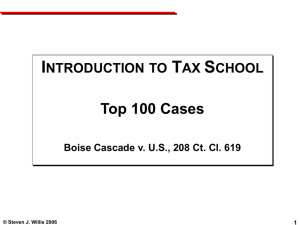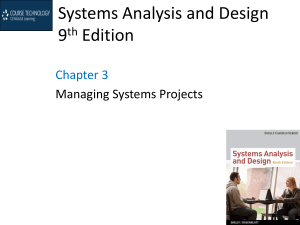
When to Use a Cascade (Waterfall) Chart
When to Use a Cascade Chart
Use a Cascade (waterfall) chart when you want to map changes in key
variables (profit, contribution or sales) between periods and show why they
changed.
Some examples of when you would use a Cascade Chart are to illustrate:
• Cost Breakdown
• Profit Breakdown
• Profit Change
• Multi-Year Profit Change
• Growth Breakdown
• Growth Breakdown—Vertical
• Growth Over Time by Category
• Comparing an Average and a Top Performer
Copyright 2012 © Knowledge Management Associates, LLC. All rights reserved.
Cost Breakdown
$15M
$2.2M
10
$0.8M
$0.4M
$0.7M
$12.2M
Other
Total
Expenses
$1.8M
$6.3M
5
0
Salary
Benefits
Rent
Technology
Training
You can use a Cascade chart to breakdown total expenses into its component
parts. The above example could be the cost structure of an IT consulting firm.
Copyright 2012 © Knowledge Management Associates, LLC. All rights reserved.
Profit Breakdown
Profit Contribution by Practice Area
$20M
$2.1M
-$0.4M
$3.6M
15
$15.4M
-$0.7M
$4.5M
10
$6.3M
5
0
Strategy
Process Technology
ERP
Cloud
Corporate
Total
Overhead Expenses
You can perform a similar analysis to the cost breakdown for revenue or profit.
This is an example of profit by division or practice area. You can show both
positive and negative contributions to profit. This is not the case if you used a
pie chart.
Copyright 2012 © Knowledge Management Associates, LLC. All rights reserved.
Profit Change
Net Income Change from 2010 to 2011
$3,000M
$1,737M
2,000
-$367M
-$243M
-$244M
-$159M
-$37M
1,000
$1,000M
-$293M
$606M
0
2010 Net Revenue Cost of Marketing
Income Increase Revenue & Sales
R&D
G&A
Other
Taxes
2011 Net
Income
One of the most common uses of a Cascade chart is to show profit change
from year to year. Start with year 1 profit, show the key change elements,
and end with year 2 profit.
Source: The Facebook Waterfalls
Copyright 2012 © Knowledge Management Associates, LLC. All rights reserved.
Multi-Year Profit Change
Net Income Change from 2010 to 2012
$800M
600
$606M
$22M
$34M
$662M
$12M
New
Products
2011 Net
Income
Current
Product
Growth
$46M
$720M
New
Products
2012 Net
Income
400
200
0
2010 Net
Income
Current
Product
Growth
You can extend the Cascade to display multi-year profit changes. In this
example, new products contribute significantly to growth.
Copyright 2012 © Knowledge Management Associates, LLC. All rights reserved.
Growth Breakdown
100
38%
100%
Other cities
and rural
Global GDP
Growth
80
19%
60
18%
40
13%
20
0
Number
of Cities
Share of
Population
12%
Megacities
(>10M
population)
Large
Midsize
Small
Middleweights Middleweights Middleweights
(5-10M)
(2-5M)
(150K-2M)
23
45
144
388
-
5%
5%
7%
7%
75%
Cascade charts can break down growth over time. It could be revenue, profit or in
this case global GDP growth. This chart is a bit more complex, but it has a
powerful message. 60% of global GDP growth between 2007 and 2025 will come
from the 600 largest cities, even though these cities make up only 25% of the
world’s population. Data columns added to the Cascade show number of cities
and share of population. Source: McKinsey, Urban world: Mapping the economic power of cities
Copyright 2012 © Knowledge Management Associates, LLC. All rights reserved.
Growth Breakdown - Vertical
Contribution to Global GDP Growth 2007-2025
Number
of Cities
Global GDP
Growth
Share of
Population
100%
Other cities and
rural
38%
Small
Middleweights
(150K-2M)
19%
Midsize
Middleweights
(2-5M)
18%
Large
Middleweights
(5-10M)
13%
Megacities
(>10M
population)
12%
0
25
50
75
-
75%
388
7%
144
7%
45
5%
23
5%
100%
You can also view Cascade charts vertically. In this case, it’s easier to see the
relationship between GDP growth, and share of population.
Source: McKinsey Global Institute
Copyright 2012 © Knowledge Management Associates, LLC. All rights reserved.
Growth Over Time by Category
Projected global energy supply mix in quadrillions of BTUs
600
500
18
24
4
7
7
10
3
16
2
Nuclear
Renewables
Nuclear
400
Renewables
Renewables
Fossil Fuels
591
Natural
Gas
Natural
Gas
Coal
Coal
200
Liquids
Liquids
0
2010
Natural
Gas
Coal
(China)
Coal (ex
China)
Liquids
Liquids
Nuclear
(China) (ex China)
Hydro
Wind
Other
2020
renewables(forecast)
You can breakdown change over time. In this chart, we examine the growth in
energy supply between 2010 and 2020. Two-thirds of the growth will come
from fossil fuels with a shift to natural gas and an increased consumption of oil
and coal in China driving the growth.
Source: Bain & Company, Eight Great Trillion Dollar Growth Trends to 2020
Copyright 2012 © Knowledge Management Associates, LLC. All rights reserved.
Comparing an Average and a Top Performer
Cost per degree delivered
$80,000
75,000
$74,268
7%
70,000
5%
65,000
8%
60,000
3%
$57,153
Non-core services
Top Quartile
55,000
50,000
Average
Completion
efficiency
Instruction
Core supports
You can illustrate how an average performer differs from a top performer. In
this example, we compare the cost per degree delivered in an average
competitive bachelors/masters program to a top quartile program.
Source: McKinsey, Winning by Degrees
Copyright 2012 © Knowledge Management Associates, LLC. All rights reserved.
Choosing the Right Chart for the Job
A successful business chart should help you as well as your audience make
sense of what would otherwise be complex numbers and ideas. When
designed poorly, charts just confuse. But choosing the right chart and utilizing
good chart design will convey your message clearly and effectively.
For more information on other charts available in Mekko Graphics and when
the right way to use them please explore the following resources:
Mekko Graphics charts not available in PowerPoint:
Marimekko Chart
Bar Mekko Chart
Our Chart Finder and Sample Presentations can help you learn about other
charts enhanced by Mekko Graphics
Copyright 2012 © Knowledge Management Associates, LLC. All rights reserved.












